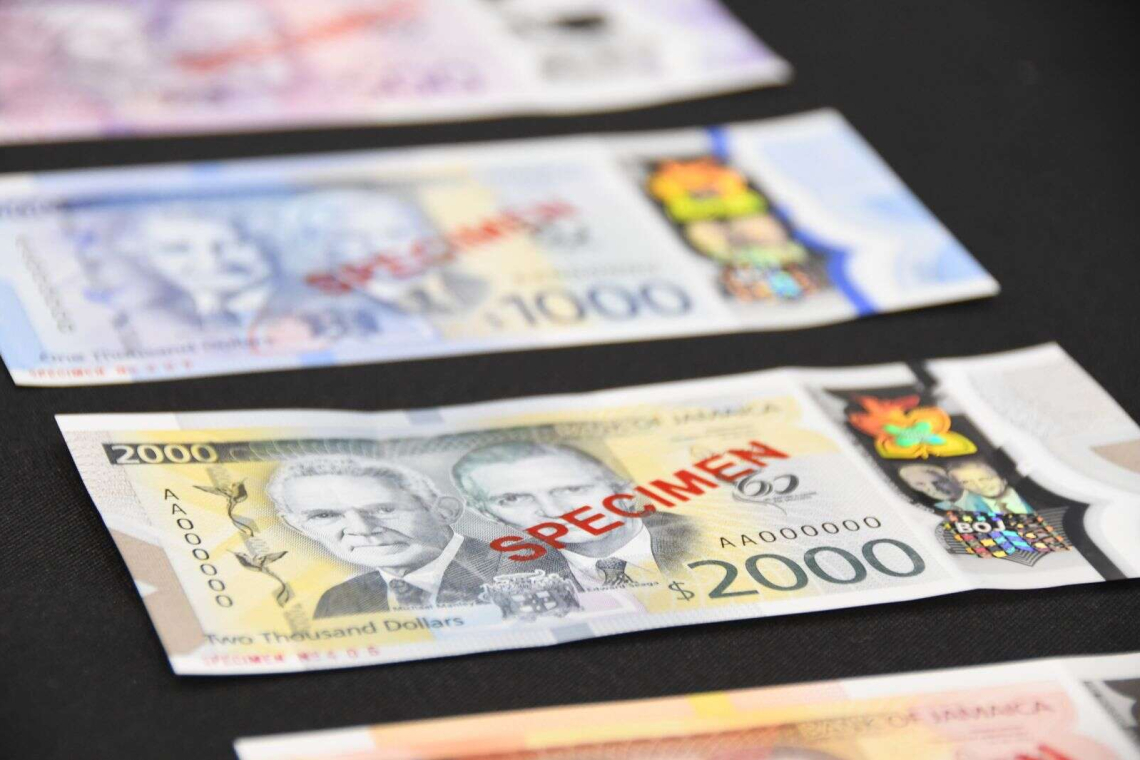Specimens of the new notes.
KINGSTON, Jamaica--For only the second time since Independence, Jamaica has introduced a new series of banknotes, which are set to be released on a phased basis in 2023.
The Bank of Jamaica (BOJ) on Thursday, December 15, launched the revamped series developed on polymer substrate, which the central bank says is more durable, resulting in cost savings and a longer-lasting product. BOJ officials said that the purpose of the launch was to show the notes as being ready.
Printed by banknote printers De La Rue, the new notes are JMD 50 (US $0.33), JMD 100 (US $0.65), JMD 500 (US $3.26), JMD 1,000 (US $6.51) and JMD 5,000 (US $32.57) plus a sixth, the JMD 2,000 (US $13.03), which was introduced. The 2,000 note is being introduced in order to make it easier for the settlement of cash transactions.
Deputy Governor Natalie Haynes said at the launch that new security features were more on the higher value notes, noting as well that because the new polymer notes were more durable, the bank no longer expected to order new notes printed every year.
BOJ Governor Richard Byles said, “The notes will enter circulation on a phased basis in 2023,” with it being otherwise noted that distribution is set for the period January to June.
A De La Rue representative present at the launch stated that moving to polymer significantly reduces counterfeits. Haynes, in response to queries, declined to disclose further security features, stating that these will be part of a public education campaign to come.
She also declined to disclose the cost of printing the new issue, saying that the subject matter was part of the contract with printer De La Rue.
The deputy governor noted that as commercial banks returned old notes, they will no longer be returned, but both old and new currencies will remain legal tender until the BOJ decides otherwise, a process likely to occur over two years.
Governor Byles, in his address, noted, “The new notes have more state-of-the-art security features, as well as features to be used by the visually impaired, including a more durable substrate” with raised touch and feel features.
Byles said that the new issue also addressed the confusion addressed by users about the 500 and the 5,000 banknotes not being easily distinguishable from each other. The redesign, he stated, addresses this, as well as improving efficiency and providing cost savings.
“The new notes are printed on polymer substrate which provides a 50% longer average circulation life span. Going forward, the reordering frequency will be lower,” the governor said.
He noted that arrangements are being made for disposal of polymer waste without environmental impact.
Minister of Finance Dr. Nigel Clarke said, “Technology is evolving … across the Caribbean countries, many, many governments have moved away from paper-based notes to polymer.” The minister of finance and the public service noted that, apart from security features, durability and features for the visually impaired, “we have been able to ensure that multiple banknote producers can produce them. Some of the notes introduced over two decades are notes that only one producer can produce. Going forward this is an improvement to be welcomed.”
He said, “the opportunity that has been presented by the conversion of these factors allowed us to engage in a redesign of notes without changing the existing policy for what appears on our banknotes. The existing policy is that we reflect on the notes our culture, our history and any face that appears is that of a national hero or a deceased prime minister.
“A people who do not acknowledge their history and the role played by those who came before, what we will do is attribute all progress to foreign benefactors, and not see ourselves as a people capable of achieving the destiny which belongs to us.
“We could never countenance the introduction of banknotes that do not include them … our banknotes must reflect that history and that struggle which occurred over centuries, and let little girls and little boys see on a daily basis the pride with which we hold those who fought. Within the context of our banknotes, it is a restoration of the original intent, the continuous struggle and achievements of us as people. It is also good that we have been able to add another of our deceased prime ministers on a banknote.
“With that policy we have seven national heroes and four deceased prime ministers, 11 figures represented on six notes.”
Officials at the launch noted that notwithstanding use of digital currency Jam-Dex, cash remains important. According to the central bank, as of November 16, there were 252 million pieces of notes in circulation in Jamaica with a total value of JMD 198.3 billion (US $1.29 billion). Of that, the majority JMD 161.75 billion (US $1.05 billion) is in the hands of the public, while JMD 43.2 billion (US $281 million) is held in banks.
The BOJ indicates that an equivalent amount of new series is available to replace the current series. Note, however, that the current series of banknotes will remain legal tender until Bank of Jamaica makes a decision regarding demonetisation of the same. ~ Jamaica Observer ~







